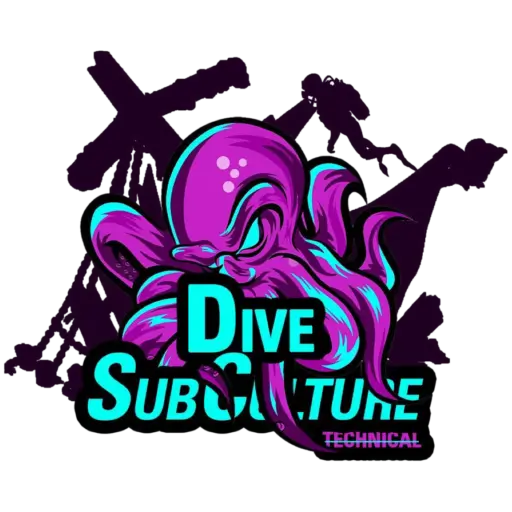

Technical Guidelines - Dive Subculture Technical
For Students of Dive Subculture Technical

Course Preparation
To ensure you maximize your time in the water and minimize environmental impact, we highly recommend completing the theory portion of your course online before arriving. This approach will:
- Save you valuable time during your holiday.
- Conserve natural resources by reducing paper usage.
For access to e-learning codes, please email us at dive@divesubculture.com. Alternatively, we can mail you the course manuals upon request.
Candidate Requirements
Candidates must bring with them a solid foundation of diving experience appropriate to the specific technical course being undertaken. You should also:
- Meet the course prerequisites.
- Be confident in the water, with strong basic skills, particularly buoyancy.
- Have a responsible attitude and a willingness to learn.
Remember, certification is not guaranteed; it is earned through demonstrated performance at the end of the course, assessed by your instructor. Training is purchased, but certification is granted only upon meeting performance standards. We recommend adding 1–2 extra days to your holiday in case additional dives or theory sessions are required.
In the event of a non-passing score, candidates will need to complete additional dives for certification. With guidance and supervised practice, skills such as gas sharing, equipment handling, and valve shutdowns can be refined to a competent level, ensuring you are fully prepared for real-world scenarios.
Pre-Dive Planning
We follow strict protocols for dive planning and gas management:
- OC PO2 Limits: 1.4 ATA for bottom gas, 1.6 ATA for decompression.
- CCR Setpoints: To be discussed based on the specific dive plan.
- Standard Gases: We encourage the use of standard gas mixes (e.g., 50% and 100%).
Additional Planning Guidelines:
- Max END for Trimix Dives: 40 meters.
- We dive air to 55–60 meters with experienced divers, and we teach TDI Decompression Procedures on air to a depth of 45 meters.
- Contingency Plans: Every dive is backed by contingency planning, including scenarios for dives going too deep, gas loss, and CCR bailout options.
Gas Analysis & Management:
- All gases must be analyzed and labeled with MOD, date, and name. Deco bottles are pre-labeled.
- Turn Pressure (TP): Pre-determined based on minimum gas requirements to ensure two divers can return to the deco switch. Extra deco gas is brought if needed.
TDI Pre-Dive Checklist:
Ensure the checklist “START” is completed before all dives.
During the Dive
- Boat Diving: All decompression dives are conducted from boats to allow for simplified entry/exit and prompt emergency response if necessary. Spare deco gases are kept on the boat.
- Emergency Protocols: If a yellow balloon is deployed, our boatmen are trained to drop spare deco gases down the line. Each boatman carries an Emergency Action Plan, and the dive center has a comprehensive emergency action plan for all situations (e.g., lost diver, injured diver).
On Every Tech Dive (Simulated or Real Decompression):
- Perform DATA checks every 5 minutes.
- Practice emergency drills on each dive, including:
- Air Sharing
- Valve Management
- Gas Switches
•SMB/Lift Bag Deployment
Post-Dive Procedures
-
After every decompression dive, the boatmen will assist in carrying equipment off the boat. A thorough debrief will follow, addressing any safety concerns or areas for diver improvement.
Dive Subculture Technical Safety Protocol
These guidelines ensure the safety and well-being of all technical divers under Dive Subculture Technical’s supervision, whether for training or fun dives. Dives are conducted in environments suitable for divers’ experience and certification levels, with comprehensive safety logistics in place (e.g., Oxygen, First Aid kits, communication). All boats carry Oxygen, and our instructors are FRTI Dive Medic and FRTI Oxygen Provider certified.
General Safety Guidelines:
- Medical Certificate: Prior to starting the course, submit a valid medical certificate. A “fit to dive” certificate from a diving physician may be required.
- Dive Computers: Carry both a main dive mixed-gas computer and a backup depth and time device.
- Dive Plan Approval: For dives deeper than 40 meters or those requiring decompression gases, an approved dive plan is mandatory.
- Logbooks: A daily logbook must be signed by each student.
- Gas Analysis: All gas mixes must be analyzed, correctly labeled with MOD, and signed by the user.
- PO2 Limits: Maximum bottom PO2 is 1.5 ATA, while decompression PO2 must not exceed 1.6 ATA.
- Gas Supply: Ensure enough gas to complete the dive within the rule of thirds or according to the dive plan.
- SMB and Reel: Divers must carry at least one reel and SMB/lift bag. Two are highly recommended.
Our Dive Subculture Technical Diving staff will assist with dive planning using the latest dive software and will reserve the final judgment on the suitability of dive sites.
These guidelines are designed to provide you with a safe, structured, and enriching technical diving experience. We look forward to diving with you!





